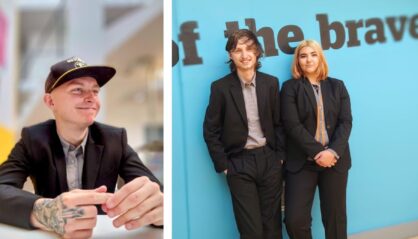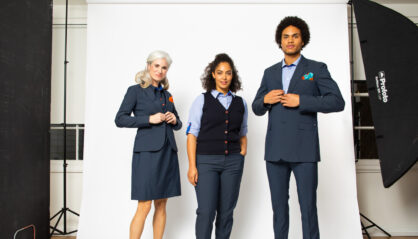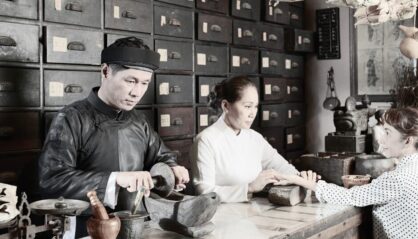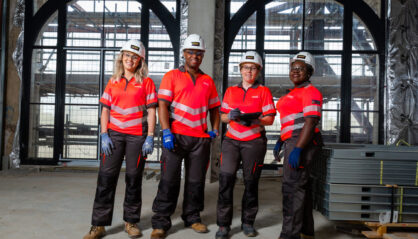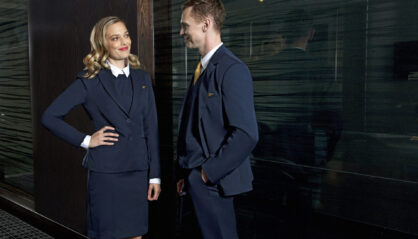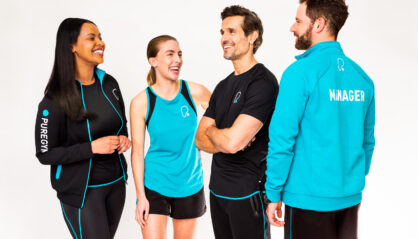How Airline Uniforms Have Changed Over The Years

Mirroring the constant change in fashion, technology and cultural biases, aviation, like many other industries, has gone through a range of changes when it comes to their uniforms. As early as the 20th century, the skies were being explored. Pioneers, such as Amelia Earhart and Frank Whittle were dominating the air. As this was seen as a much more daring endeavour, airline uniforms typically prioritised practicality over style. Many pilots opted to wear leather jackets and flight caps. These hardy garments, alongside goggles, would protect these brave flyers from the elements around them. However, as aviation travel advanced, so did the uniforms.
According to an article from Southern Living, ‘the first in-flight hostesses in the 1930s and 1940s wore military-inspired skirt suits in bland hues, white gloves, and matching hats’ and it was until the 1950 and 1960’s that ‘femininity and glamour took reigns with bouffant hair, pillbox hats, and funky mod looks making waves’. With a focus more on airlines and their identity through their uniforms, certain materials and design techniques were incorporated to ensure these garments were comfortable and smart.
The Dawn Of Aviation
The fashion of aviation tends to mirror the style of the time. Air travel, in its pioneering days, was seen as a luxury. Only the wealthy could afford to use planes and therefore flight attendants had to match this level of sophistication.
In 1934, Swissair, a European flight company, had their air hostess wear a traditional uniform silhouette of the time, in plain colours. To ensure that an appearance of opulence was upheld, they would often accessorise with the addition of hats. On American Airlines, they were following a similar trajectory by dressing their air hostesses in conservative silhouettes. These style uniforms would typically be created in thick military-style fabrics, paired with matching hats.
The Age Of Jets
In the 1950s and 1960s air travel became a lot more accessible, and therefore uniforms also began to see a modernisation. In 1950, uniforms were still holding onto that ‘ultra-traditional’ style. Influenced massively by the military and nurse style of the time, uniforms were typically cinched at the waist and paired with a traditional hat.
Whereas in 1958, airhostess started to model a tea-length set, alongside hats and white gloves. Many people deemed air hostesses as ‘the Supermodels of that era’, and with ‘the chic uniform, white gloves and pillbox hat’. By the end of the 1960s, the hemlines of air hostess uniforms began to go up, introducing a much more glamorous look when it came to international air travel.
The Time Of Transformation
From the 1960s to the 1980s, the women’s liberation movement exerted a profound influence on societal ideals. With women at the forefront, new feminist ideals lead to deep societal change which reverberated across various industries, including air travel and uniform choices.
In 1967, American airlines had their stewardesses sporting a tri-colour uniform which no-one had ever seen before. This naturally caught the attention of the public and was a wide-reaching talking point. These red white and blue belts and hairbows, paired with a shorter matching sheath dress was created with a feminine silhouette in mind and appear more comfortable than previous iterations.
Also inspired by the significance of the women’s liberation movement, was the Southwest Airlines flight attendants in Texas. Moving with the times, this airline had their team incorporating fashion forward trends such as go-go boots and belted mini skirts in their uniforms.
According to this article from SFO Museum, ‘the impact of trends and modern style on airline uniforms continued into the 1970s’. In line with the growing women’s liberation movement, airline uniforms began to ‘include trousers—a first for female flight attendant wear.’ The traditional skirt and jacket combination of previous decades were becoming less prominent and the hostess took the option of wearing trousers. These were deemed as more functional and comfortable cabin crew uniforms. Southwest Airlines were the first to embrace this trend, when in 1970, they had their crew wear flamboyant striped trousers.
The Modern Era
Style, functionality and brand identity are the cornerstones of a 21st century uniform. In the modern day, many airlines are collaborating directly with a range of designers to create bespoke uniforms which reflect all three of these elements.
An excellent demonstration of this was our collaboration alongside Butlins in 2023. As a leading global uniform supplier, we were extremely excited to design and develop a brand new uniform for the iconic Butlin establishment. During 2023, Butlin’s were seeking a re-design of their well known Redcoat.
They wanted a fresh new look, which would go hand-in-hand with their brand’s overall purpose. Our Head of Design, Nihal Selimi explained it best when she said: “They wanted their Redcoat team to feel special wearing the famous jacket. They wanted it to reflect their brand themes of ‘playful, pioneering, positive, inclusive, welcoming and unpretentious’.
Whilst Butlins is not an airline, there is a focus on creating uniforms that are both functional and comfortable. Whether the role of hospitality takes place in the sky or at your local Butlins, uniforms have to prioritise the balance between the brand’s image with the practicality of the job.
Sustainable and Innovative Uniforms
In modern times, there has been a significant trend that leans towards integrating sustainable practices whenever possible – including uniform design and creation. With a variety of eco-friendly fabrics now readily available, numerous industries are opting for the use of recycled and biodegradable materials to craft their customised work attire.
This continues to reflect a growing concern for the environmental impact we are having. In an effort to reduce their overall carbon footprint, uniforms created from sustainable materials are much more likely to align with customers’ ideals as well as promote a ‘greener’ message for businesses.
An article from Simple Flying emphasises how even in the airline industry, many companies are taking the route of making their uniforms more environmentally-conscious. In late 2023, ‘Thai Airways unveiled new sustainable cabin crew uniforms, blending recycled material and Thai silk’. These brand new uniforms were accompanied by an exciting announcement that this specific airline is looking to reduce their net emissions to zero by the end of 2050. These advancements in textile technology have led to uniforms which can not only offer great comfort to a team of crew members, but also are better for the planet.
Looking Ahead
As we move forward, we anticipate that airline uniforms will continue to be driven by consumer preferences, similar to the eco-friendly changes we are already witnessing. As technological innovations advance, so will uniforms. As the needs of passengers and crew evolve, airlines will most likely integrate more advanced materials and ergonomic designs to enhance comfort and provide the functionality that this job role will require.
Designing Custom Workwear For Businesses Since 1981
At JSD, we specialise in the creation, production, and management of the uniform design process. No matter the business’s requirements, we research the industry in depth before designing a uniform that fits the brand’s aesthetics and needs. In terms of the process, we also handle everything from development to manufacturing. This involves creating the patterns needed to make various samples and taking these specifications through to production.
Throughout our design process, each client is assigned a dedicated account manager who oversees the customisation of workwear clothing to align with their specific operational needs, priorities, and in-house resources. Finally, in terms of logistics and distribution, here at Jermyn Street Design, we also manage the shipping, storage, and distribution of all our uniforms. Our uniforms are not only created with your team in mind, but also the environment. Reach out to our team today if you’re seeking to enhance your company’s image and customer perception through uniforms designed not only with your team in mind but also with the environment in consideration.
